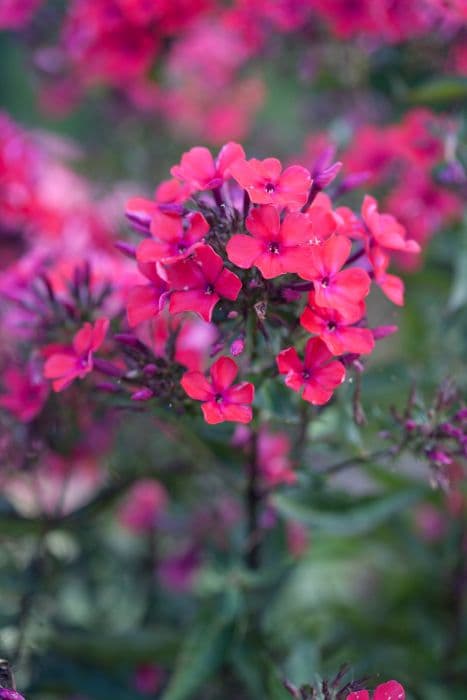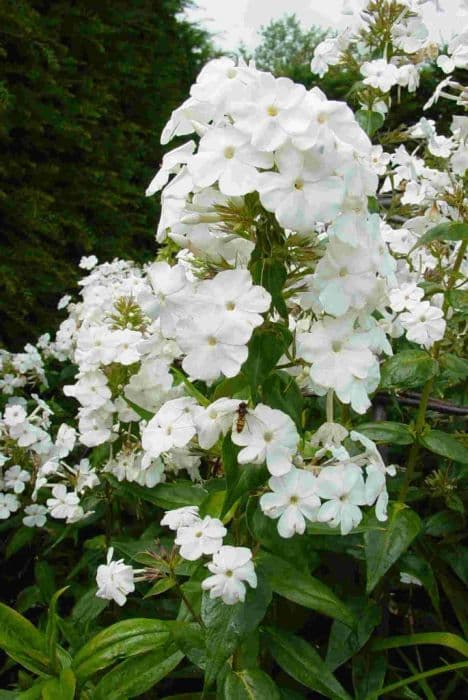Garden Phlox Phlox paniculata 'Logan Black'

ABOUT
Phlox paniculata 'Logan Black' is an ornamental plant known for its striking appearance. It showcases clusters of eye-catching flowers with a deep, vibrant purple hue. These blooms often exhibit a lighter or white eye at the center, adding a dramatic contrast and depth to the floral display. The flowers are arranged in a panicle, which is a branched cluster of flowers where the branches are typically arranged along a central stem. The foliage of 'Logan Black' consists of lance-shaped leaves that exhibit a lush, deep green color. These leaves are attached to the stems, which provide a sturdy backdrop for the prominent flowers. When in bloom, the plant offers a spectacular show, attracting hummingbirds, butterflies, and other pollinators to the garden with its colorful flowers and pleasant fragrance. This particular variety of phlox is appreciated for its longevity in blooming, which can last through the summer months. The plant's growth habit is upright and forms a bushy clump. Given its appealing aesthetic and growth characteristics, Phlox paniculata 'Logan Black' is a popular choice for garden beds, borders, and is also suitable for cut flower arrangements due to its attractive flower clusters. It adds a splash of color and can be used effectively to create a focal point in the garden.
About this plant
 Names
NamesFamily
Polemoniaceae
Synonyms
Garden Phlox, Summer Phlox, Perennial Phlox, Tall Phlox
Common names
Phlox paniculata 'Logan Black'.
 Toxicity
ToxicityTo humans
Garden Phlox is generally considered non-toxic to humans, and there are no well-documented cases of poisoning from ingesting this plant. However, as with many plants, mild stomach upset is possible if plant parts are ingested. It is always advisable to avoid eating ornamental plants, as individual sensitivities can vary.
To pets
Garden Phlox is also generally considered non-toxic to pets, and there is no significant data suggesting that the ingestion of this plant poses a serious risk to animals. However, as with any non-food plant, ingestion could potentially cause mild gastrointestinal upset in some pets, including symptoms like vomiting or diarrhea. It is always best to prevent pets from chewing on ornamental plants to avoid any possible issues.
 Characteristics
CharacteristicsLife cycle
Perennials
Foliage type
Deciduous
Color of leaves
Green
Flower color
Purple
Height
2-4 feet (60-120 cm)
Spread
2-3 feet (60-90 cm)
Plant type
Herb
Hardiness zones
4
Native area
North America
Benefits
 General Benefits
General Benefits- Attracts pollinators: Garden Phlox is known for its ability to attract bees, butterflies, and other beneficial insects to the garden, which can aid in pollination of nearby plants.
- Ornamental value: With its deep-colored blooms and attractive foliage, Garden Phlox offers aesthetic appeal and can serve as an eye-catching addition to flower beds and borders.
- Fragrance: Garden Phlox flowers have a pleasant fragrance that can add a sensory experience to gardens and landscapes.
- Long blooming period: Phlox paniculata 'Logan Black' typically has a long blooming season, which can provide extended color and interest in the garden.
- Perennial growth: As a perennial plant, Garden Phlox will come back year after year, reducing the need for annual planting and providing a dependable structure in the garden design.
- Drought tolerance: Once established, many varieties of Garden Phlox, including 'Logan Black', are relatively drought-tolerant, requiring minimal watering in the right conditions.
- Versatility: Garden Phlox can be used in a variety of garden settings, including borders, rock gardens, and as background plants in mixed flower arrangements.
- Wildlife habitat: By providing nectar, Garden Phlox can help support local wildlife, including birds that may feed on the insects attracted to the blooms.
- Cut flowers: Phlox paniculata is suitable for cutting and can be used in floral arrangements, adding its beauty and fragrance to indoor environments as well.
 Medical Properties
Medical PropertiesThis plant is not used for medical purposes.
 Air-purifying Qualities
Air-purifying QualitiesThis plant is not specifically known for air purifying qualities.
 Other Uses
Other Uses- Garden Path Lining: Phlox paniculata is often used to line garden paths, providing a lush, colorful border that guides visitors through the landscape.
- Pressing and Flower Crafts: The vibrant blossoms of the Phlox can be pressed and used in flower crafts such as greeting cards, bookmarks, and framed art.
- Educational Tool: Horticultural programs and schools might use the Phlox to help students learn about plant identification, growth patterns, and breeding.
- Photography Subject: The striking appearance of Phlox paniculata makes it a favorite subject for photographers practicing macro and nature photography.
- Livestock Feed Addition: In some cases, the non-toxic parts of Phlox paniculata may be added to livestock feed as a nutritional supplement.
- Mulch Material: Once the plant is spent at the end of the growing season, it can be cut down and used as a rich, organic mulch around other plants.
- Beekeeping Attractant: Phlox paniculata can be planted near beehives as an attractant, providing a nectar source for honey production.
- Companion Planting: Gardeners might plant Phlox paniculata alongside vegetables to attract pollinators and enhance the overall health and yield of the garden.
- Natural Dye: The flowers of Phlox paniculata can be used to produce natural dyes for fabrics or art projects.
- Landscaping Themes: Phlox can be used in moon gardens or white-themed gardens due to the light color of some varieties, offering visual interest during twilight hours.
Interesting Facts
 Feng Shui
Feng ShuiThe garden phlox is not used in Feng Shui practice.
 Zodiac Sign Compitability
Zodiac Sign CompitabilityThe garden phlox is not used in astrology practice.
 Plant Symbolism
Plant Symbolism- Harmony - Phlox paniculata, commonly known as garden phlox, is often associated with harmony due to its clusters of flowers that bloom together seamlessly.
- Unity - The dense grouping of its flowers symbolizes unity, as they stand together on a single stem.
- Agreement - Garden phlox is suggestive of agreement in thoughts or actions, reflecting the plant's uniform and consistent blooming pattern.
- Proposal - In the language of flowers, gifting phlox can represent a proposal or offer due to its charming and inviting appearance.
- Sweet Dreams - This particular plant is also linked to the notion of sweet dreams, potentially because of its pleasant fragrance and the calming effect of watching a well-tended garden as the day fades.
 Water
WaterGarden Phlox should be watered deeply and thoroughly, ensuring that the soil is moist but not waterlogged. It's best to provide about one inch of water per week, either through rainfall or manual watering. During hot or dry spells, you may need to water twice a week. Water at the base of the plant to keep the foliage dry, which helps prevent disease. Adjust your watering schedule according to the weather and soil conditions to avoid overwatering.
 Light
LightGarden Phlox thrives in full sunlight but can tolerate partial shade. It performs best when it receives at least six hours of direct sunlight each day. An ideal spot for Garden Phlox would be in an area where it can bask in the morning sun and have some protection from the intense afternoon rays, especially in hotter climates.
 Temperature
TemperatureGarden Phlox does well in a wide range of temperatures and can survive in zones 4 through 8. It can tolerate minimum temperatures down to -30°F and can handle summer temperatures of up to 85°F. For optimal growth, Garden Phlox prefers to be in an environment where the average temperature is between 65°F and 75°F.
 Pruning
PruningPruning Garden Phlox helps to promote healthy growth, improve air circulation, and increase the number of blooms. Deadhead spent flowers to encourage new blooms and cut back the plant after flowering has finished to tidy its appearance. Prune out any dead or diseased stems throughout the growing season. The best time for a significant prune is in late winter or early spring, before new growth begins.
 Cleaning
CleaningAs needed
 Soil
SoilGarden Phlox thrives in a soil mix that is rich in organic matter with good drainage, with a pH range of 6.0 to 7.0, which is slightly acidic to neutral. To prepare the best soil mix for Garden Phlox, blend garden soil with compost or peat moss, and sand to improve drainage. Regular applications of a balanced, slow-release fertilizer can benefit overall vigor.
 Repotting
RepottingGarden Phlox, being a perennial, does not need frequent repotting and is typically planted directly into the garden. This plant is generally not suitable for pot cultivation over long periods, but if grown in containers, repotting every 2-3 years in spring would suffice to refresh the soil and provide more room for root growth.
 Humidity & Misting
Humidity & MistingGarden Phlox prefers moderate humidity, but is adaptable to the ambient humidity found in most temperate climates. It does not require any special humidity adjustments when grown outdoors, which simplifies its care significantly.
 Suitable locations
Suitable locationsIndoor
Provide bright light, and water when the soil feels dry.
Outdoor
Plant in sun to part shade, rich well-draining soil.
Hardiness zone
4-8 USDA
 Life cycle
Life cyclePhlox paniculata 'Logan Black', commonly known as Tall Garden Phlox, begins its life cycle as a seed that germinates in spring when soil temperatures rise. The seedling grows into a clump-forming perennial with strong stems and dark green foliage, typically reaching full size within a few months. During summer, the plant produces clusters of scented, deep purple or black flowers that attract pollinators such as bees and butterflies. Following pollination, the flowers develop into small seed pods that ripen by fall, releasing seeds for the next generation. Throughout the winter, the plant enters a dormant phase, dying back to the ground after frost hits, but its root system remains alive underground. In the spring, new shoots emerge from the surviving roots, repeating the yearly growth cycle.
 Propogation
PropogationPropogation time
Spring-Summer
Propogation: The most popular method for propagating Garden Phlox, specifically the 'Logan Black' variety, is by division, which is typically done in early spring or early fall when the plant is not in active bloom. To propagate by division, you first dig up an established clump of phlox and gently separate it into smaller sections, making sure that each section has a good amount of roots and at least a few shoots. After the division, the sections should be replanted at the same depth they were growing before and spaced approximately 18 to 24 inches (about 45 to 60 centimeters) apart to give each new plant sufficient room to grow. The soil should be kept evenly moist until the new divisions are well established. This method of propagation helps rejuvenate older plants, encourages vigorous growth, and is an effective way to increase the number of plants in your garden.









